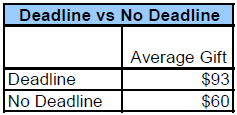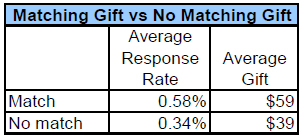When it comes to online fundraising, there is no “one size fits all” magic formula to inspire list members to give. However, some tactics do work better than others. In an attempt to find out which strategies work best and when, we reviewed more than 180 fundraising appeals sent out over the course of the 2006 calendar year by nine prominent national non-profit organizations (see Study Participants for a full list). We explored everything from “double your money” matching gift opportunities to deadline-driven campaigns to goal-oriented asks. For the purposes of our analysis, we grouped the appeals we reviewed into one or more of the following four tactic categories:
- Multiple Appeal Series – Messages sent as part of a cohesive, multiple appeal campaign over the course of three weeks were compared to stand alone appeals that were not part of a larger series.
- Deadline-Driven – Stand alone or multiple appeal series that used a deadline to drive giving were compared to those without a deadline.
- Matching Gift – Stand alone or multiple appeal fundraising series that included a matching gift offer were compared to those without a matching gift element.
- Dollar Goal – Stand alone or multiple appeal series that focused on reaching a monetary goal were compared to those that did not make use of a dollar goal.
However, many of the messages we reviewed fell into more than one of these categories – for example, a three-appeal matching gift series with a deadline of June 2nd and a goal of raising $25,000 would fall into all four categories. Because there are substantial variations in response rate, average gift, etc., among the organizations, we chose to evaluate these four tactics within each organization rather than compare the messages to each other.1 This led to a fairly small sample size, making it harder to draw definitive conclusions; however, our results did trend toward statistical significance in three of the four tactic categories.
Multiple Appeal Series
Perhaps the most striking finding was the difference between multiple appeal series (a fundraising campaign made up of two or more appeals) and single or “stand-alone” fundraising appeals. We found that the multiple fundraising appeal series2 tended to outperform one-time appeals, resulting in both a higher response rate and a higher average gift.
3p=.06 a d p<.01
Deadline-Driven Appeals and Series
The results of our analysis showed that appeals and series that included a deadline by which gifts must be made tended to be more effective than open-ended appeals without specific deadlines. Although the difference between average gifts was significant, the difference between the response rates was not statistically significant (so we have not included it here).
Although further analysis (ideally with a larger sample size) is warranted, it appears that deadlines, whether tied to some real-life event or introduced without explanation, do tend to boost the returns on a fundraising appeal or campaign.
Matching Gifts
Despite the fact that our small sample size prevents us from drawing any firm conclusions, the results of the analysis did trend towards significance. It appears that the idea of making a donation that will be doubled by another donor (or group of donors) is motivational to many online donors. A matching gift campaign also provides the perfect rationale to introduce a deadline and to send out multiple appeals, both good ways to boost returns. p=.07 a =.04
Dollar Goals
Unfortunately, the jury is still out on the effectiveness of including a dollar goal in a fundraising appeal. The results of our analysis were not large enough (again, possibly because of the small sample size) to be considered statistically significant. However, setting a dollar goal for a fundraising campaign does provide a solid rationale for setting a deadline to reach the goal and for sending multiple appeals leading up to the deadline – both tactics which are likely to increase response rates overall.
Conclusion
No matter what your current fundraising strategies or goals are, we recommend that you continue to test different messaging hooks and tactics to find out which ones work best for your audience. A carefully-crafted multiple appeal series could be used in conjunction with stand alone messages, and might just increase your response rates and overall donations. Deadlines, matching gifts, and dollar goals are creative (and often effective) ways of raising money and engaging your email list members. Every organization has unique and specific needs, but the strategies described above are a useful place to start testing new approaches.
Study Participants
- DonorsChoose
- League of Conservation Voters
- National Parks Conservation Association
- Oxfam America
- Planned Parenthood Federation of America
- Phil Angelides’ Campaign for Governor of California
- Public Campaign
- Save Darfur Coalition
- The Wilderness Society
Study Methodology
We reviewed more than 180 fundraising appeals sent out by the nine non-profit organizations listed above between January and December of 2006. We examined appeals in four categories: appeal vs. series, deadline-driven vs. no deadline, matching gift vs. no match, and dollar goal vs. no goal. As explained above, every fundraising appeal was categorized by whether it was a member of each appeal category, this allowed for messages to belong to none of these categories or all of these categories.
Because differences among the organizations’ message tone and donor bases were difficult to control for, we compared messages by fundraising tactic within organizations. One downside tousing this ‘paired samples’ data was that it kept our sample size small (n=9), which reduced our ability to generalize the results to all organizations.
Given that our sample size was so small, it is encouraging to see some statistically significant (at the .05 level) results in the data we presented. Our results did trend toward statistical significance in three of the four tactics we investigated. ‘Statistical significance’ means that the differences we found within the paired samples were unlikely to be the result of chance variations. For more information about statistical significance check out: https://www.statsoft.com/textbook/esc.html.
Notes:
- For more information on study methodology and statistical significance of results, please see Study Methodology.
- For the purposes of this evaluation, we combined the data for all the messages in a multiple appeal series into one line of data and then compared that with a “stand alone” counterpart.
- “p” is the probability that our data don’t represent the actual difference between response rates and average gift size based on fundraising series strategy. A p of .06 is read as 11 percent. In this study we used a one-tailed hypothesis test for each pairwise comparison.



